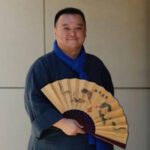My grandmother passed away in Vietnam in the late 1990s. I was only able to visit her once while she was alive. During that one visit, my mom made it a point to pre-pay for my grandmother’s plot, along with related end-of-life expenses. She knew it might be difficult for her to return to Vietnam when my grandmother died, so she wanted to have these payments taken care of.
My grandmother was a devotee at a Chinese Buddhist temple in Vietnam, which also had a branch in Los Angeles, where my family lived. So, when she died, we received a lot of support from priests and volunteers, including help with wiring funds for incidental costs. My mother also requested a placard to be installed in the memorial hall in Los Angeles so that we could pay our respects locally.
In East Asian culture, the remembrance of ancestors is later generations expressing gratitude to earlier generations in the form of ritual. You could say that remembrance is thanking the ancestors for building a foundation of work ethic and respect, or thanking the ancestors for planting the seed and nurturing the tree so later generations can enjoy its shade.
“Placards act as a lotus seat for the deceased to listen, join in the daily chanting, and receive teachings.”
During certain services in these temples, one can find an altar with rows of yellow placards lined up with a Buddha statue and some offerings. This is the liberation shrine or memorial altar. Those yellow placards, listed with names of the deceased, are representations of “lotus seats.” Throughout the service, the deceased are invited to listen in on the service and receive the merit or blessings that have been generated from it.
Not only family members are enshrined and remembered, but also friends, karmic debt collectors, wandering spirits, disaster victims, and so on. They can all receive the merit from services. At the end of the service, the placards are burned as a ceremonial send-off to the Pure Land. Some temples even choose to create long-term, permanent wooden placards as well. What is the meaning behind these placards?
It’s believed that the tradition of memorial placards comes from The Twenty-Four Filial Exemplars, an ancient Confucian text exploring filial piety. One of the exemplars in this text is Ding Lan. He never had a chance to serve his parents because they died when he was young. So, in tribute, he carved statues of them out of wood and then served them as if they were still alive. Ding Lan’s wife did not want to revere them anymore, and she started to prick the fingers of the statues. Ding Lan later found the statues with blood flowing from their fingers and tears rolling from their eyes. The use of statues for honoring ancestors later evolved into the paper and wooden placards we see at some Buddhist temples today.
These placards act as a lotus seat for the deceased to listen, join in the daily chanting, and receive teachings. The food offerings to the ancestors are an extra benefit for them. I like to think of it as, “Come for the wisdom, stay for the food.”
The placards also serve as a place for someone to pay their respects to an ancestor when it is impossible to visit the grave. For example, my family left Vietnam because of war, so we’re not able to visit our ancestors’ graves. The placard at our affiliated temple in Los Angeles gave us a place to go to remember our ancestors.
I heard a conversation over the weekend with a few of the monks at a local temple. One of them expressed his viewpoint of a memorial shrine. Let’s call him H. H is under the impression that the younger generation is not interested in these placards, and there’s no longer a use for them. H mentioned that for the temple he planned to acquire, he was going to burn all the permanent placards and reuse the space for other purposes. That made me sad, until H said he was unsuccessful in acquiring the temple.
I guess it could be true that younger generations do not have a lot of interest in this practice, but that’s an assumption. It could be that they are interested; they just can’t find a place to start due to language barriers or whatnot.
As a chaplain, I know rituals can be helpful for families to find closure to their grief. The memorial hall can be a space for them to express their memories and/or feelings. For me, placards and all the rituals around them help me connect with my grandma and others in the afterlife. It gives me a sense of closure to know that, even after their death, I can still offer something to my loved ones.
This article was published in the May 2024 issue of Bodhi Leaves: The Asian American Buddhist Monthly.


